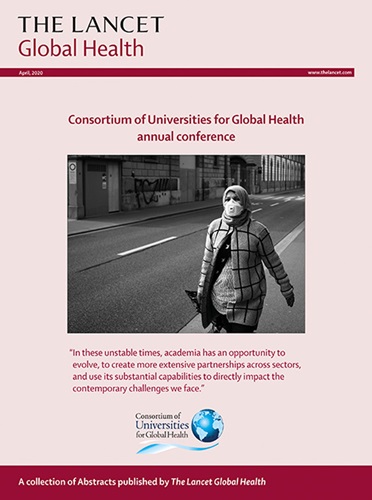Effect of a participatory whole-systems approach on mortality in children younger than 5 years in Jigawa state, Nigeria (INSPIRING trial): a community-based, parallel-arm, pragmatic, cluster randomised controlled trial and concurrent mixed-methods process evaluation.
IF 19.9
1区 医学
Q1 PUBLIC, ENVIRONMENTAL & OCCUPATIONAL HEALTH
引用次数: 0
Abstract
BACKGROUND In 2019, Nigeria reported the highest mortality rate in children younger than 5 years globally. We aimed to assess a whole-systems approach to improving child mortality in northern Nigeria. METHODS We conducted a community-based, parallel-arm, pragmatic, cluster randomised controlled trial in Kiyawa local government area, Jigawa state, Nigeria, and a concurrent mixed-methods process evaluation using ethnography and quantitative implementation monitoring. Trial clusters were population catchment areas of 32 government primary health-care facilities. Compounds were randomly sampled, proportional to cluster size, and all women aged 16-49 years and children younger than 5 years who were permanent residents were eligible for inclusion and recruited as the evaluation population. Children younger than 7 days were recruited but excluded from analysis. Evaluation clusters were allocated to intervention or control via simple randomisation with a 1:1 ratio. Cluster names were written on paper, folded, and placed in a container by community representatives. Different community representatives took out names one by one, with the first half assigned to receive the intervention. The intervention consisted of three components: participatory learning and action (PLA) groups for men and women (including compound heads [ie, the member of the compound that residents deemed most senior]), partnership defined quality scorecard (PDQS), and health-care worker capacity building; it was delivered from March 1, 2021, to Dec 31, 2022. We could not mask participants, field staff, or intervention-delivery staff to cluster allocation but baseline, endline, and follow-up data excluded information on cluster allocation. PLA groups involved separate groups of up to 25 men or women from all villages in the intervention clusters. The primary outcome was all-cause mortality in children aged 7 days to 59 months between Oct 1, 2021, and Sept 20, 2022, referred to as the evaluation period. The trial was prospectively registered (ISRCTN 39213655) and the protocol has been published. FINDINGS We recruited 3800 compounds at baseline, with 12 893 children contributing to analysis of the primary outcome (7316 [56·8%] of 12 893 in the intervention group and 5577 [43·3%] in the control group). 6617 (51·3%) of 12 893 children were male, 6275 (48·7%) were female, and one (<0·1%) child had missing sex data. Sampled compounds randomly came from 388 (91·3%) of 425 villages in the 32 clusters. We conducted verbal autopsies for 1182 deaths, of which 369 (31·2%) were children aged 7 days to 59 months during the evaluation period. Of these 369, 91 (24·7%) were classified as pneumonia deaths. Children contributed a median 361 days (IQR 236-365) to the analysis, with 369 (2·9%) of 12 893 children censored on their date of death, 1545 (12·0%) on their 5th birthday, and 3392 (26·3%) on the date of the most recent follow-up in which their residence or survival status was known. We found no significant decrease in all-cause mortality (hazard ratio 0·95, 95% CI 0·68-1·33; p=0·79) or suspected pneumonia mortality (0·79, 0·43-1·46; p=0·46) in the intervention group. The process evaluation showed low coverage and issues in reach of the intervention, but qualitative data highlighted mechanisms for positive effects on health and relationships. INTERPRETATION Our intervention did not affect mortality. However, due to the high child mortality in this region, further efforts should be made to adapt our participatory whole-systems approach to use communities of action within compounds. FUNDING GSK and Save the Children UK. TRANSLATION For the Hausa translation of the abstract see Supplementary Materials section.参与式全系统方法对尼日利亚吉加瓦州 5 岁以下儿童死亡率的影响(INSPIRING 试验):一项基于社区、平行臂、务实、群组随机对照试验和同时进行的混合方法过程评估。
背景2019年,尼日利亚报告的5岁以下儿童死亡率居全球之首。我们在尼日利亚吉加瓦州基亚瓦地方政府辖区开展了一项基于社区、平行臂、务实、分组随机对照试验,并同时使用人种学和定量实施监测进行了混合方法过程评估。试验群组是 32 个政府初级卫生保健设施的人口聚集区。根据群组大小按比例随机抽样,所有年龄在 16-49 岁之间的妇女和 5 岁以下的儿童,只要是常住居民,都有资格被纳入并被招募为评估人群。小于 7 天的儿童也被纳入其中,但不在分析之列。通过简单的随机分配,以 1:1 的比例将评估群组分配给干预组或对照组。社区代表将群组名称写在纸上,折叠后放入容器中。不同的社区代表逐个取出名字,前一半被分配接受干预。干预措施由三部分组成:男性和女性参与式学习与行动(PLA)小组(包括院落负责人[即院落中居民认为资历最深的成员])、伙伴关系定义的质量记分卡(PDQS)和医护人员能力建设;实施时间为2021年3月1日至2022年12月31日。我们不能将参与者、现场工作人员或干预实施人员与分组分配相混淆,但基线、终点和随访数据不包括分组分配信息。PLA 小组包括来自干预群组中所有村庄的最多 25 名男性或女性组成的独立小组。主要研究结果是 2021 年 10 月 1 日至 2022 年 9 月 20 日期间 7 天至 59 个月儿童的全因死亡率,这段时间被称为评估期。该试验进行了前瞻性注册(ISRCTN 39213655),并公布了试验方案。结果我们招募了 3800 名基线化合物,其中 12 893 名儿童参与了主要结果分析(干预组 12 893 名儿童中有 7316 名[56-8%],对照组 5577 名[43-3%])。在 12 893 名儿童中,6617 名(51-3%)为男性,6275 名(48-7%)为女性,1 名(<0-1%)儿童性别数据缺失。采样院落随机来自 32 个群组 425 个村庄中的 388 个(91-3%)。在评估期间,我们对 1182 例死亡病例进行了口头尸检,其中 369 例(31-2%)为 7 天至 59 个月大的儿童。在这 369 例死亡中,有 91 例(24-7%)被归类为肺炎死亡。儿童参与分析的时间中位数为 361 天(IQR 236-365),在 12 893 名儿童中,有 369 名(2-9%)儿童的死亡日期被剔除,1545 名(12-0%)儿童的死亡日期被剔除,3392 名(26-3%)儿童的死亡日期被剔除,这些儿童的居住地或存活状况在最近一次随访中均为已知。我们发现,干预组的全因死亡率(危险比 0-95,95% CI 0-68-1-33;P=0-79)或疑似肺炎死亡率(0-79,0-43-1-46;P=0-46)没有明显下降。过程评估显示,干预措施的覆盖率较低,在覆盖范围方面存在问题,但定性数据强调了对健康和人际关系产生积极影响的机制。然而,由于该地区的儿童死亡率较高,应进一步努力调整我们的参与式全系统方法,在院落内使用行动社区。
本文章由计算机程序翻译,如有差异,请以英文原文为准。
求助全文
约1分钟内获得全文
求助全文
来源期刊

Lancet Global Health
PUBLIC, ENVIRONMENTAL & OCCUPATIONAL HEALTH-
CiteScore
44.10
自引率
1.20%
发文量
763
审稿时长
10 weeks
期刊介绍:
The Lancet Global Health is an online publication that releases monthly open access (subscription-free) issues.Each issue includes original research, commentary, and correspondence.In addition to this, the publication also provides regular blog posts.
The main focus of The Lancet Global Health is on disadvantaged populations, which can include both entire economic regions and marginalized groups within prosperous nations.The publication prefers to cover topics related to reproductive, maternal, neonatal, child, and adolescent health; infectious diseases (including neglected tropical diseases); non-communicable diseases; mental health; the global health workforce; health systems; surgery; and health policy.
 求助内容:
求助内容: 应助结果提醒方式:
应助结果提醒方式:


